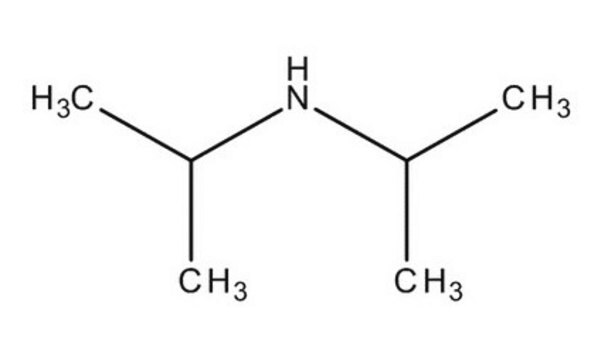38292
Diisopropylamine
analytical standard
Synonyme(s) :
DIPA
About This Item
Produits recommandés
Qualité
analytical standard
Niveau de qualité
Densité de vapeur
3.5 (vs air)
Pression de vapeur
50 mmHg ( 20 °C)
Pureté
≥99.5% (GC)
Température d'inflammation spontanée
599 °F
Durée de conservation
limited shelf life, expiry date on the label
Limite d'explosivité
8.5 %
Technique(s)
HPLC: suitable
gas chromatography (GC): suitable
Indice de réfraction
n20/D 1.392 (lit.)
n20/D 1.392
Point d'ébullition
84 °C (lit.)
Pf
−61 °C (lit.)
Solubilité
H2O: soluble 110 g/L at 25 °C (completely)
Densité
0.722 g/mL at 25 °C (lit.)
Application(s)
environmental
Format
neat
Chaîne SMILES
CC(C)NC(C)C
InChI
1S/C6H15N/c1-5(2)7-6(3)4/h5-7H,1-4H3
Clé InChI
UAOMVDZJSHZZME-UHFFFAOYSA-N
Vous recherchez des produits similaires ? Visite Guide de comparaison des produits
Description générale
Application
Produits recommandés
Mention d'avertissement
Danger
Mentions de danger
Classification des risques
Acute Tox. 3 Inhalation - Acute Tox. 4 Oral - Aquatic Chronic 3 - Eye Dam. 1 - Flam. Liq. 2 - Skin Corr. 1B - STOT SE 3
Organes cibles
Respiratory system
Code de la classe de stockage
3 - Flammable liquids
Classe de danger pour l'eau (WGK)
WGK 2
Point d'éclair (°F)
7.8 °F - closed cup
Point d'éclair (°C)
-13.45 °C - closed cup
Équipement de protection individuelle
Faceshields, Gloves, Goggles, type ABEK (EN14387) respirator filter
Faites votre choix parmi les versions les plus récentes :
Déjà en possession de ce produit ?
Retrouvez la documentation relative aux produits que vous avez récemment achetés dans la Bibliothèque de documents.
Notre équipe de scientifiques dispose d'une expérience dans tous les secteurs de la recherche, notamment en sciences de la vie, science des matériaux, synthèse chimique, chromatographie, analyse et dans de nombreux autres domaines..
Contacter notre Service technique








